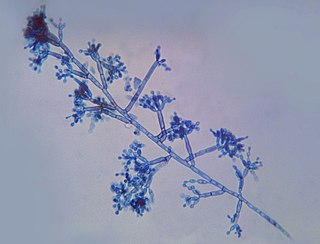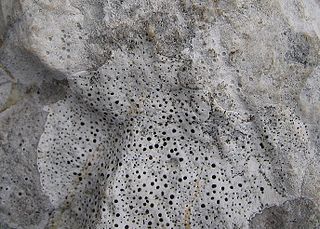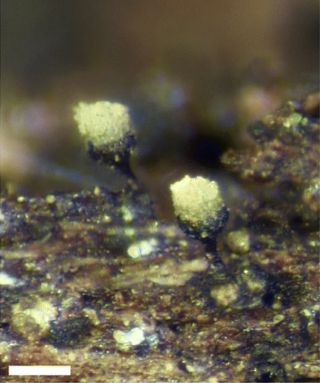
Dothideomycetes is the largest and most diverse class of ascomycete fungi. It comprises 11 orders 90 families, 1,300 genera and over 19,000 known species. Wijayawardene et al. in 2020 added more orders to the class.
Chaetothyriomycetidae is a subclass of fungi within the Eurotiomycetes. They are collectively termed the black yeasts. The subclass was revised in 2014.

The Chaetothyriales are an order of ascomycetous fungi in the class Eurotiomycetes and within the subclass Chaetothyriomycetidae. The order was circumscribed in 1987 by mycologist Margaret Elizabeth Barr-Bigelow.

The Xylariales are an order of fungi within the class Sordariomycetes, subdivision Pezizomycotina, division Ascomycota. It was the original order of the subclass Xylariomycetidae. Xylariales was circumscribed in 1932 by Swedish mycologist John Axel Nannfeldt, and Xylariomycetidae by Ove Erik Eriksson and Katarina Winka in 1997. In 2020, more families were added to the order.

The Hysteriaceae are a taxonomic family of fungi and the only extant family of the order Hysteriales. Members of the Hysteriaceae are defined by the possession of a sexual structure called the hysterothecium, an elongated structure that opens by a longitudinal slit and releases sexually produced spores. The family is widely distributed, with many species found in temperate regions, and most are saprobic on wood and bark, although a few are parasitic on plants.

The Dactylosporaceae or Sclerococcaceae are a family of lichen-forming fungi in the class Eurotiomycetes. It is the only family of the order Sclerococcales and subclass Sclerococcomycetidae.

Verrucariales is an order of ascomycetous fungi within the subclass Chaetothyriomycetidae of the class Eurotiomycetes. Although most of the Verrucariales are lichenised, the family Sarcopyreniaceae consists of 11 species of lichenicolous (lichen-dwelling) fungi.

The Pyrenulales are an order of ascomycetous fungi within the class Eurotiomycetes and within the subphylum Pezizomycotina.
Capronia is a genus of fungi in the family Herpotrichiellaceae. It has about 80 species.
Cercidospora is a genus of fungi in the class Dothideomycetes. The relationship of this taxon to other taxa within the class is unknown. The genus was first described by Gustav Wilhelm Körber in 1865; it is synonymous with the name Prolisea described by Frederick Edward Clements in 1931.
The Papulosaceae are a family of fungi in the class Sordariomycetes and in the subclass Diaporthomycetidae. The family has not been assigned to any order. A monotypic taxon, the Papulosaceae contained the single genus Papulosa, which in turn contains the single species Papulosa amerospora. This species, found in the eastern USA, grows in Juncus stems.

Eurotiomycetidae is a subclass of the Eurotiomycetes.
Myrmecridium is a genus of fungi in the class Sordariomycetes. It was circumscribed in 2007 and is distinguished from similar fungi by having entirely hyaline (translucent) vegetative hyphae and widely scattered, pimple-shaped denticles on the long hyaline rachis. The generic name derives from a combination of the Ancient Greek word "myrmekia", meaning "wart", and the suffix "-ridium" from "Chloridium".
Phaeomoniella is a genus of hyphomycete fungi in the family Celotheliaceae. The genus was circumscribed by Pedro Crous and Walter Gams in 2000 to contain the type species, P. chlamydospora, the causal agent of Petro grapevine decline, a disesase in the esca disease complex. Phaeomoniella is similar to Phaeoacremonium, differing in cultural characteristics, and in the morphology of the conidiophores and conidia.

Sclerococcum is a genus of lichenicolous fungi in the family Dactylosporaceae.

Cryptocalicium is a single-species fungal genus of the order Eurotiomycetes that was circumscribed in 2021. It contains the species Cryptocalicium blascoi. Cryptocalicium is the only genus in the monotypic family Cryptocaliciaceae, the order Cryptocaliciales and the subclass Cryptocaliciomycetidae.
Celotheliaceae is a family of fungi in the monotypic order Phaeomoniellales. The family was proposed in 2008 by Robert Lücking, André Aptroot, and Harrie Sipman, while the order was circumscribed in 2015. It is sister to the clade that includes the orders Verrucariales and Chaetothyriales. Molecular clock calculations suggest that the order originated when gymnosperm diversification occurred.

Diaporthomycetidae is a subclass of sac fungi under the class Sordariomycetes.
Conioscyphales is an order of freshwater and terrestrial fungi within the division Ascomycota. It is in the subclass Savoryellomycetidae and the class Sordariomycetes and the subdivision of Pezizomycotina.











